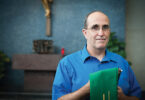by Father Gary Pennings
Father Gary Pennings is the vicar general for the archdiocese and director of the diaconate.
During this Year of Faith, we commemorate the 50th anniversary of the opening of the Second Vatican Council, the most recent of 21 ecumenical councils in the history of the Catholic Church. One of the fruits of Vatican II was the renewal of the order of deacons.
In the Bible, we first encounter deacons in the Acts of the Apostles (Acts 6:2) when the apostles selected seven men to care for the poor and thus freed up the apostles for preaching. By the end of antiquity, deacons were close collaborators and assistants to the bishops, taking care of church property and administrative matters. In the early Middle Ages, many deacons were recognized as playing vital roles in the life of the church, and, between the years 432 and 684, a large number of them were elected pope (they were, of course, ordained priests and bishops before assuming the office).
By the end of the first millennium, however, the diaconate began to change into a transitional step on the way to priesthood ordination. In 1967, Pope Paul VI, acting on the teaching about deacons articulated at Vatican II, established norms for the restoration of the diaconate as a permanent ministry in the church.
All Christians, configured to Christ in baptism, share in Jesus’ priestly, prophetic and royal offices, but some in the church are called to ordained service. Deacons, as members of the Catholic clergy, become part of the hierarchy of the church, the “third rank of holy orders.” They are co-workers with the bishops and priests, but deacons are ordained not to priesthood, but to a ministry of service. They are called to be the icons of Christ the servant.
It is certainly true, of course, that countless laymen and women in the church perform marvelous ministries and acts of service, but for deacons, their ministry is strengthened by the grace of the sacrament of holy orders.
Deacons are at the service of the people of God in the ministry of the liturgy, of the word of God, and of charity. As icons of Christ the servant, in their lives and ministry deacons are called to witness selfless service. Many Catholics might not be aware that when a bishop vests for an ordination or similar solemn Mass, he will wear a dalmatic, the vestment of a deacon, beneath his outer vestment. The deacon vestment underscores for the bishop not so much the fullness of the priesthood, but service as an important characteristic of his ministry.
The presence of permanent deacons serving in our archdiocese helps remind me, a priest, of my own diaconal ordination that took place prior to my priesthood ordination. Deacons help me to remember the ministry of service to which I, too, am still called. They serve as “sacramental signs” that help remind all of us to more closely imitate Christ Jesus, who came “not to be served, but to serve” (Mk 10:45).

